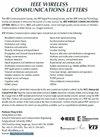GS3D:基于高斯散射-协同稳定扩散的三维无线网络信号恢复
IF 5.5
3区 计算机科学
Q1 COMPUTER SCIENCE, INFORMATION SYSTEMS
引用次数: 0
摘要
三维(3D)无线网络集成了地面基站(BSs)、空中平台、低地球轨道(LEO)和地球静止卫星(GEO),可以提供全球覆盖,实现第六代(6G)无线网络中无处不在的可靠通信。尽管有这种潜力,但这种网络的一个关键挑战是管理来自不同高度密集部署的节点的干扰,这可能会显著降低整体性能并破坏无缝通信。为了解决这一挑战,在这封信中,我们提出了一种新的高斯飞溅-协同稳定扩散(GS3D)模型,用于在下行3D无线网络中执行信号恢复。具体来说,我们考虑了一个场景,其中LEO卫星星座(SatCon)服务于运动中的地球站(esim),而地面基站、空中平台,包括无人机(uav)、高空平台(HAPs)和GEO卫星会对这些esim产生干扰。研究结果表明,与目前最先进的去噪扩散概率模型(DDPM)和正则化零强迫(RZF)方案相比,GS3D模型可以显著提高信号恢复精度。本文章由计算机程序翻译,如有差异,请以英文原文为准。
GS3D: Signal Recovery in 3-D Wireless Networks With Gaussian Splatting-Synergized Stable Diffusion
Three-dimensional(3D) wireless networks, that integrate terrestrial base stations (BSs), aerial platforms, low earth orbit (LEO), and geostationary (GEO) satellites, can offer global coverage, enabling ubiquitous and reliable communication in sixth-generation (6G) wireless networks. Despite this potential, one key challenge in such networks is managing interference from densely deployed nodes at varying altitudes, which can significantly degrade the overall performance and disrupt seamless communication. To address this challenge, in this letter, we propose a novel Gaussian splatting-synergized stable Diffusion (GS3D) model to perform signal recovery in downlink 3D wireless networks. Specifically, we consider a scenario, where LEO satellite constellation (SatCon) serves earth stations in motion (ESIMs), while terrestrial BSs, aerial platforms, including unmanned aerial vehicles (UAVs), high altitude platforms (HAPs), and GEO satellites introduce interference to these ESIMs. Our results show that the proposed GS3D model can significantly improve the signal recovery accuracy compared to the state-of-the-art denoising diffusion probabilistic model (DDPM) and the regularized zero-forcing (RZF) scheme.
求助全文
通过发布文献求助,成功后即可免费获取论文全文。
去求助
来源期刊

IEEE Wireless Communications Letters
Engineering-Electrical and Electronic Engineering
CiteScore
12.30
自引率
6.30%
发文量
481
期刊介绍:
IEEE Wireless Communications Letters publishes short papers in a rapid publication cycle on advances in the state-of-the-art of wireless communications. Both theoretical contributions (including new techniques, concepts, and analyses) and practical contributions (including system experiments and prototypes, and new applications) are encouraged. This journal focuses on the physical layer and the link layer of wireless communication systems.
 求助内容:
求助内容: 应助结果提醒方式:
应助结果提醒方式:


